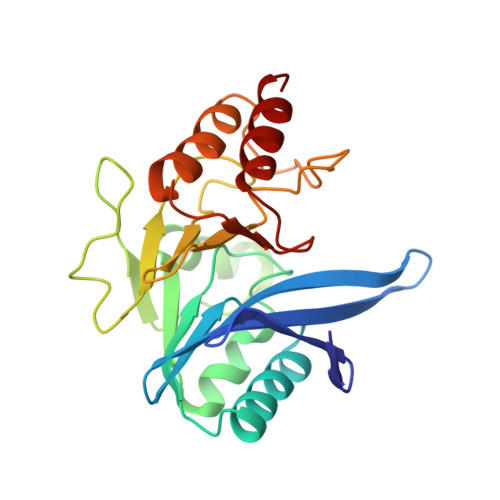NMR Characterization of the Influence of Zinc(II) Ions on the Structural and Dynamic Behavior of the New Delhi Metallo-beta-Lactamase-1 and on the Binding with Flavonols as Inhibitors.
Riviere, G., Oueslati, S., Gayral, M., Crechet, J.B., Nhiri, N., Jacquet, E., Cintrat, J.C., Giraud, F., van Heijenoort, C., Lescop, E., Pethe, S., Iorga, B.I., Naas, T., Guittet, E., Morellet, N.(2020) ACS Omega 5: 10466-10480
- PubMed: 32426604
- DOI: https://doi.org/10.1021/acsomega.0c00590
- Primary Citation of Related Structures:
6TT8, 6TTA, 6TTC - PubMed Abstract:
New Delhi metallo-β-lactamase-1 (NDM-1) has recently emerged as a global threat because of its ability to confer resistance to all common β-lactam antibiotics. Understanding the molecular basis of β-lactam hydrolysis by NDM is crucial for designing NDM inhibitors or β-lactams resistant to their hydrolysis. In this study, for the first time, NMR was used to study the influence of Zn(II) ions on the dynamic behavior of NDM-1. Our results highlighted that the binding of Zn(II) in the NDM-1 active site induced several structural and dynamic changes on active site loop 2 (ASL2) and L9 loops and on helix α2. We subsequently studied the interaction of several flavonols: morin, quercetin, and myricetin were identified as natural and specific inhibitors of NDM-1. Quercetin conjugates were also synthesized in an attempt to increase the solubility and bioavailability. Our NMR investigations on NDM-1/flavonol interactions highlighted that both Zn(II) ions and the residues of the NDM-1 ASL1, ASL2, and ASL4 loops are involved in the binding of flavonols. This is the first NMR interaction study of NDM-1/inhibitors, and the models generated using HADDOCK will be useful for the rational design of more active inhibitors, directed against NDM-1.
- Institut de Chimie des Substances Naturelles, CNRS UPR 2301, Université Paris-Sud, Université Paris-Saclay, LabEx LERMIT, 1 avenue de la Terrasse, 91190 Gif-sur-Yvette, France.
Organizational Affiliation:


















